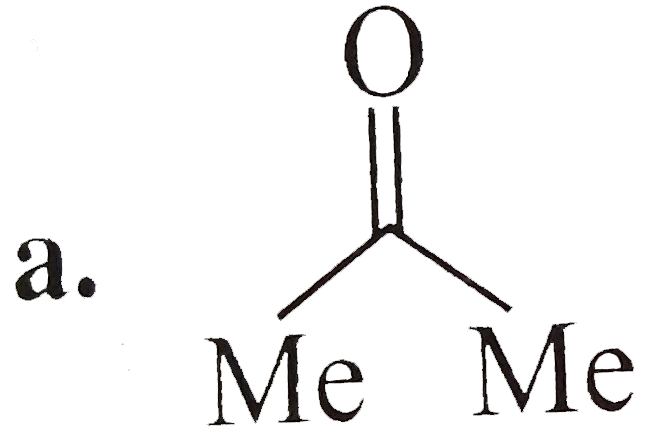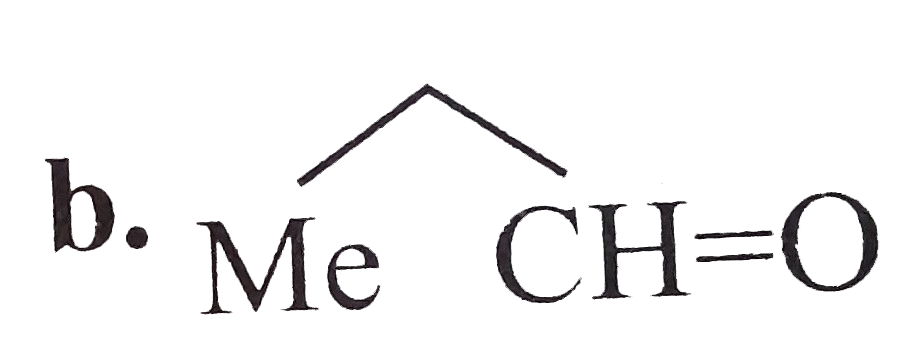(A)
(B) Gives positive Tollens test but negative iodform test.
(C ) Give negative Tollens test but positive iodoform test.
The compound (B) is:
a.
b.
c.
d.Both and
The correct Answer is:D
To solve the problem step by step, we will analyze the information given and apply our knowledge of organic chemistry, specifically focusing on ozonolysis and the tests for aldehydes and ketones.
Step 1: Identify Compound A
- We are given that compound A has the formula C₇H₁₄. This indicates that it is an alkene.
- The general formula for alkenes is CₙH₂ₙ, and for C₇, it fits this formula. Therefore, compound A is likely to be heptene (C₇H₁₄).
Hint: Remember that alkenes follow the formula CₙH₂ₙ, which helps in identifying the type of compound.
Step 2: Ozonolysis of Compound A
- Ozonolysis of alkenes typically results in the formation of carbonyl compounds (aldehydes and/or ketones).
- In this case, when heptene (C₇H₁₄) undergoes ozonolysis, it will yield two products: one will be an aldehyde (B) and the other will be a ketone (C).
Hint: Ozonolysis splits the double bond and forms carbonyl compounds.
Step 3: Analyze the Properties of Compound B
- We know from the problem that compound B gives a positive Tollens test and a negative iodoform test.
- Aldehydes give a positive Tollens test (indicating the presence of the aldehyde functional group) and a negative iodoform test (since they do not have the structure required for this test).
Hint: Recall that Tollens' test is specific for aldehydes, while iodoform test is for methyl ketones or alcohols.
Step 4: Analyze the Properties of Compound C
- Compound C gives a negative Tollens test but a positive iodoform test.
- This indicates that compound C is a ketone, specifically a methyl ketone (which can give a positive iodoform test).
Hint: Ketones do not react with Tollens' reagent unless they are specific types (like α-hydroxy ketones).
Step 5: Identify the Specific Compounds
- Based on the ozonolysis of heptene, we can deduce the specific compounds:
- The aldehyde (B) formed is likely propanal (C₂H₅CHO).
- The ketone (C) formed is likely butanone (C₄H₈O).
Hint: When identifying compounds, consider the structure and functional groups that match the tests provided.
Conclusion
- Therefore, compound B is propanal (C₂H₅CHO), which gives a positive Tollens test and a negative iodoform test.
- The answer to the question is that compound B is propanal.
Final Answer
The compound (B) is Propanal (C₂H₅CHO).
- We are given that compound A has the formula C₇H₁₄. This indicates that it is an alkene.
- The general formula for alkenes is CₙH₂ₙ, and for C₇, it fits this formula. Therefore, compound A is likely to be heptene (C₇H₁₄).
- Ozonolysis of alkenes typically results in the formation of carbonyl compounds (aldehydes and/or ketones).
- In this case, when heptene (C₇H₁₄) undergoes ozonolysis, it will yield two products: one will be an aldehyde (B) and the other will be a ketone (C).
- We know from the problem that compound B gives a positive Tollens test and a negative iodoform test.
- Aldehydes give a positive Tollens test (indicating the presence of the aldehyde functional group) and a negative iodoform test (since they do not have the structure required for this test).
- Compound C gives a negative Tollens test but a positive iodoform test.
- This indicates that compound C is a ketone, specifically a methyl ketone (which can give a positive iodoform test).
- Based on the ozonolysis of heptene, we can deduce the specific compounds:
- The aldehyde (B) formed is likely propanal (C₂H₅CHO).
- The ketone (C) formed is likely butanone (C₄H₈O).
- Therefore, compound B is propanal (C₂H₅CHO), which gives a positive Tollens test and a negative iodoform test.
- The answer to the question is that compound B is propanal.
The compound (B) is Propanal (C₂H₅CHO).
Topper's Solved these Questions
- REDUCTION AND OXIDATION REACTION OF ORGANIC COMPOUNDSBook:CENGAGE CHEMISTRY ENGLISHChapter:REDUCTION AND OXIDATION REACTION OF ORGANIC COMPOUNDSExercise:Exercise (Multiple Correct)
Explore 35 Videos
- REDUCTION AND OXIDATION REACTION OF ORGANIC COMPOUNDSBook:CENGAGE CHEMISTRY ENGLISHChapter:REDUCTION AND OXIDATION REACTION OF ORGANIC COMPOUNDSExercise:Exercise (Single Correct)
Explore 90 Videos
- REDUCTION AND OXIDATION REACTION OF ORGANIC COMPOUNDSBook:CENGAGE CHEMISTRY ENGLISHChapter:REDUCTION AND OXIDATION REACTION OF ORGANIC COMPOUNDSExercise:EXERCISES
Explore 1 Video
- QUALITATIVE INORGANIC SALT ANALYSISBook:CENGAGE CHEMISTRY ENGLISHChapter:QUALITATIVE INORGANIC SALT ANALYSISExercise:Viva Voce Questions And Part-C (Analysis Of Cations)
Explore 42 Videos
- SOLID STATEBook:CENGAGE CHEMISTRY ENGLISHChapter:SOLID STATEExercise:Ex 1.2 (Objective)
Explore 9 Videos
Similar Questions
(A) A(C7H14)O3/Red−−−−→B(C3H6O)+C
(B) Gives positive Tollens test but negative iodform test.
(C ) Give negative Tollens test but positive iodoform test.
The compound (C ) is:
View Solution(A) A(C7H14)O3/Red−−−−→B(C3H6O)+C
(B) Gives positive Tollens test but negative iodform test.
(C ) Give negative Tollens test but positive iodoform test.
The compound (A) is:
View Solution
Knowledge Check
A compound that gives positive iodoform test is
A1-pentanolB2-pentanoneC3-pentanoneDpentanalA compound that gives positive iodoform test is
A1-pentanolB2-pentanoneC3-pentanoneDpentanalA compound that gives positive iodoform test is
A1-pentanolB2-pentanoneC3-pentanoneDpentanal
(A) A(C7H14)O3/Red−−−−→B(C3H6O)+C
(B) Gives positive Tollens test but negative iodform test.
(C ) Give negative Tollens test but positive iodoform test.
The compound (B) can be converted to (C ) by using the reagents:
View Solution(A), (B) and (C ) are three non-cylic funtional isomers of a carbonyl compound with molecular formula C4H8O. Isomers (A) and (C ) give positive Tollen's test whereas isomer (B) does not give Tollens' test but gives positive iodoform test. Isomers (A) and (B) on reduction with Zn(Mg) | conc. HCl give the same product (D).
(a) Write the structures of (A), (B) ,(C) and (D).
(b) Out of (A), (B) and (C ) isomers, which one is least reactive towards addition of HCN ?
View SolutionAlkene (X) (C5H10) on ozonolysis gives a mixture of two compounds (Y) and (Z). Compound (Y) gives positive Fehling's test and iodoform test. Compound (Z) does not give Fehling's test but give iodoform test. Name the compound formed when Z reacts with Mg - Hg / H2O
View Solution(A)H2O∗−−−→B+C, (B) and (C) both give +ve iodoform test. Compound (A) is
View SolutionCompound X C4H8O which gives 2,4-DNP derivative and negative iodoform test is
View Solution